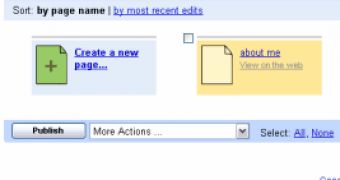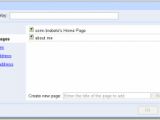Google's quest to conquering the web rages on? How? Why, of course, by launching yet another web-based service. This time, it's something really beefy and it's likely to cause quite some fuss.
Dubbed Google Page Creator (Beta at this time), the service combines an online WYSIWYG webpage designer with site hosting, without any advertisements whatsoever. Sounds interesting? Trust me, it is. Actually, you don't have to just trust me; the process of getting your own homepage is a breeze, as it only requires you to surf to http://pages.google.com and log on with your Google (Gmail) account.
The first page that hits you is a brief description (with pictures!) of the service - what it is, what it offers, and so on. To continue, you have to (carefully!) review the terms of use and? click a button. This takes you to the "Page Manager", where you can create new pages, edit, publish and duplicate existing ones, send them to your friends and perform various other actions that help you achieve a better organization.
The Page Manager also lists your "uploaded stuff" and allows you to add some more, notifies you of any changed but unpublished pages and provides access to your "site settings". The settings are not very complex but cover two (unequally) important subjects. In order of appearance, the first is the site's title (defaults to your username); the second is a checkbox which invites you to confess if your website contains adult content (interestingly enough, Google seems to approve such pages, you just have to "admit" you publish such content - "Terms and conditions require that you let us know when you're posting adult content.")
Web pages are created and modified via a very well put together AJAX-based interface, similar to the one that can be seen in Gmail (one of the best available on the net). All the basic actions can be performed, such as adding headlines, headings, subheadings, (formatted) text, bullet lists, hyperlinks and images.
Everything integrates nicely with the content you already have on your homepage (published or not). For example, when you want to add an image, you have the option of inserting one of the images you uploaded with just one click (a handy thumbnail grid is shown), after which you can use the floating toolbar to specify the image display size (resizing is done automatically).The image can be also moved around due to the transparently-drag-and-drop feature. Check out the pictures to see how these work.
Hyperlinks work similarly; you may link to one of the pages you've already created, to an uploaded file, an external site or an email address (you are warned that email addresses inserted in web pages can be found by, as Google says, "nasty spammers"). An interesting addition is the option of creating a new page on the spot and automatically link to it.
Formatting text with the various available options (columns, colors, sizes, typefaces, and so on) works just as in any other text editor.
All these come with a cost, though, as older versions of some browsers are not supported (specifically Opera and Konqueror). Trying to access the Page Creator with such a browser triggers the following message: "Sorry, your web browser is not yet supported. Our programming wizards tried their darndest to get Google Page Creator to work with as many browsers as possible. But alas, even the most expert practitioners of web sorcery must sleep now and again, lest their JavaScript magic run dry."
It would be a great injustice not to mention the wealth of "looks" and "layouts" the Page Creator offers, an excellent means of customizing your designs. Layouts define the organization of content on the page, while the look is composed of base background and foreground colors, font size, color and face, header and footer design and so on. They're all very tasteful and range from simple and elegant to colorful, optimistic and nonconformist.
Advanced features of the Page Creator include the ability to directly edit the underlying HTML code for any element, undo/redo levels and live preview of the page being currently modified without publishing it first.
But wait! In order to publish web pages, hosting space is needed. Fear not, Google took care of that too, and offers 100MB of space for your needs. While some may argue this is isn't too much, I think it's enough for the average homepage, which does not host movies (trailers, of course) or games (demos, again of course). The address at which your pages are published follows this format: http://username.googlepages.com/pagename.
People all over the world have started to create homepages using Google's new service and are already finding bugs and suggesting improvements. Retro's page, for example, reports that "Google Pages fail validation" and that users are not "able to edit an image's hyperlink, image automatically links to itself". He also has an interesting idea which will offer even more hosting space: link the 2GB available in Gmail accounts to Google Pages.
Google can't be accused of being overly creative in naming this service, but the offered features sure do compensate: easy to use but much-more-than-just-basic webpage editing capabilities, one-click instant publishing, 100MB hosting space, name.googlepages.com address, no ads? only thing missing I can think of is support for dynamic pages (via some web oriented programming language such as PHP), but who knows what the future brings?

 14 DAY TRIAL //
14 DAY TRIAL // 




